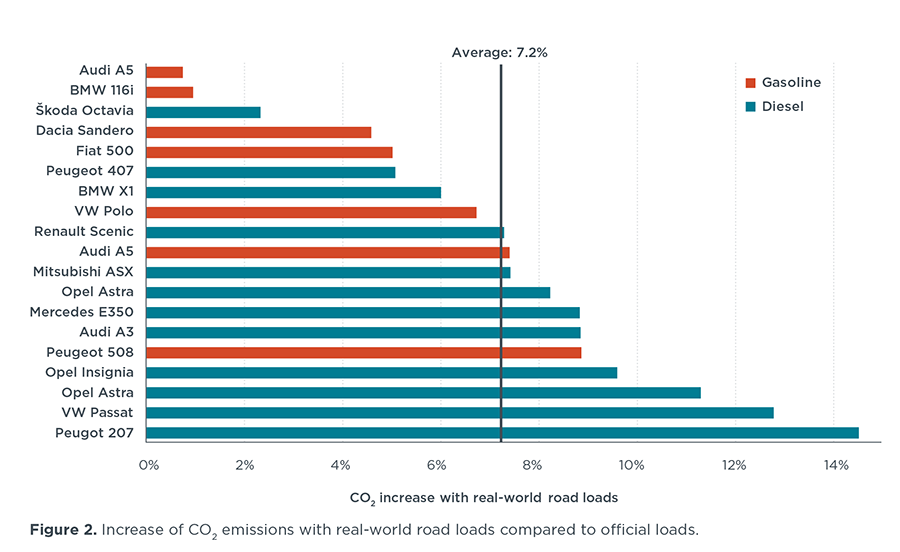White paper
Official vs. real-world road-load parameters in EU vehicle efficiency testing
On average, real-world fuel consumption and CO2 emissions of new European passenger cars exceeded official vehicle type-approval values by approximately 40 percent in 2014. This paper shows that about one-third of this gap can be explained by vehicle manufacturers systematically exploiting technical tolerances and imprecise definitions in the procedures specified for the coastdown tests that provide data used to set up lab equipment for type-approval testing.
The study focused on preparatory tests that measure forces of inertia, friction, and aerodynamic resistance affecting a vehicle on the road. Collectively these forces are referred to as “road load.” The tests, during which a vehicle is driven and then coasted (hence their name, “coastdown tests”) on a track, determine parameters required to set up a chassis dynamometer to simulate road load during a type-approval test.
The road-load coefficients greatly influence official fuel consumption and CO2 emissions values, because energy is required to overcome road load. If the coefficients used to set up the type-approval test simulate too little road load, the vehicle will consume an artificially low volume of fuel for the test, and emit less CO2. And, because coastdown testing is rarely repeated during the production cycle of a vehicle model, the initial coastdown values have a lasting impact.
The study analyzed real road-load data for 29 passenger cars from model years 2009–2012 obtained from four independent vehicle test labs. For 19 of the 29, it compared the real-world road loads to official road loads from the French and German type-approval agencies. For those models also sold in the United States, the study also compared real-world road loads to official parameters used in U.S. emissions certification tests.
For all 19 vehicles, actual road load exceeded what was simulated during type-approval tests on those vehicles. The study estimates that the influence of unrealistic road load data on CO2 emissions and fuel consumption tests produced official values between 0.7% and 14.5% lower than they would have been if actual real-world road load data had been used. Averaged across all vehicles, official CO2 emission figures were 7.2% lower than actual emissions because of the inaccurate official road-load coefficients. That figure explains one-third of the average gap between official and real-world CO2 values for new cars. By contrast, the average impact on CO2 emissions and fuel consumption of differences between the official U.S. road-load coefficients and the real-world data was only 1.8%.
The study spotlights an important difference in the transparency of the EU and U.S. vehicle regulations. While coastdown data is publicly available in the U.S., it is considered confidential business information in the EU and can currently be obtained by third parties in exceptional cases and for specific individual vehicles only. This makes it nearly impossible for independent parties to cross-check the official road-load parameters of a vehicle.
It also spotlights deficiencies in current EU vehicle testing procedure that should be remedied. The introduction of the new worldwide harmonized light vehicles test procedure (WLTP) in 2017 should be an improvement in this respect. But it is crucial to also provide for regular compliance tests, subsequent to type-approvals and carried out by the authorities, in order to ensure the reliability of information on fuel consumption and emissions of new vehicles in the future.
Attachments
ICCT_Coastdowns-EU_201605_fs.pdf

